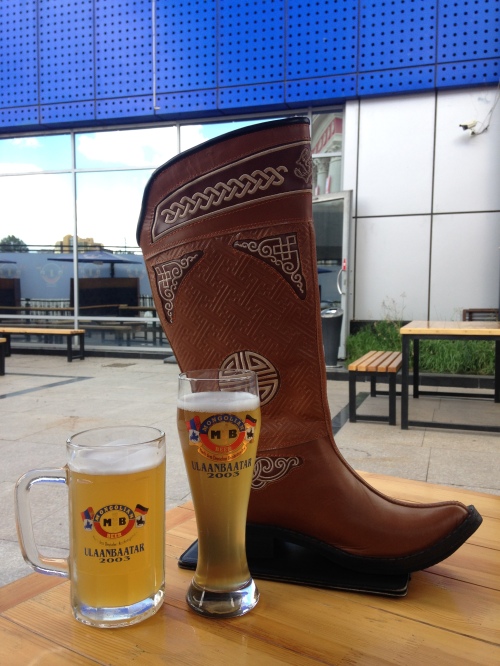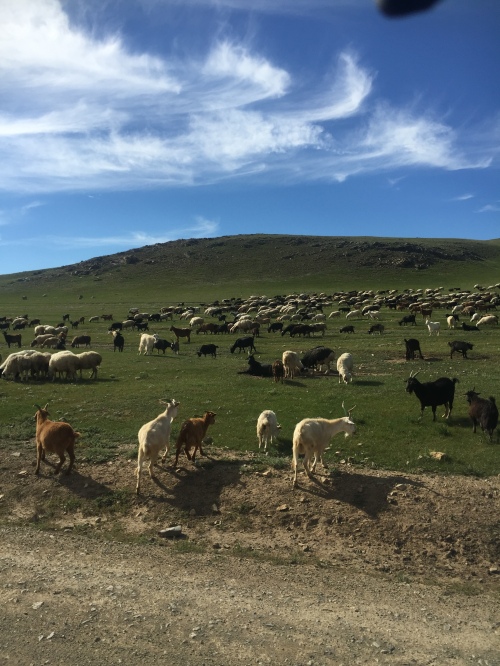
A Mop in the Road
About 150 kilometers west of Mongolia’s capital Ulan Bator (“UB”), the road abruptly ends in a cement blockade flanked by two arrows alerting drivers to go around. This is not a fork in the road- it’s more like a mop. Instead of discrete paths, there are criss-crossing strings of dirt trails that widen and shrink depending on the amount of recent rain and eventually peter out completely. With another 200 kilometers to go before our destination, it remains a mystery how our driver knew where to go. Even with his expertise though, our four-wheel-drive vehicle had to be towed across a river- twice.
The optimum vehicle in Mongolia is a horse.

Vera and I found a map store in UB.
Upon arrival to Mongolia, our van had to wait for cows to get out of the way to leave Chinggis Khaan airport. Not seeing any fences, I still wonder how they keep them off the runway.

My new riding boots, purchased at the State Department Store, marking me as a “barny” for the horse trek. I learned from one of our (15 year old) traveling companions that a barny is someone who does not know how to do something but dresses the part. Busted!
In Search of Beer
My Aussi beer traveling companion Vera (see Australia, October 2014) met me in Beijing and together we arrived in Mongolia for a two week horse trekking adventure. And, of course, we also planned to explore the imbibing culture. We found two places in UB for beer: MB Beer Plus (above left), which had a brewery on site that makes drinkable German-style lagers, and the rooftop bar of our hotel (Best Western Tuushin, above right) that served a rather flavorless mega-brewery tipple called Ghinggis Beer. We preferred the MB Plus (but wished for a more clever name) and noticed in the pub the same tension that is everywhere in UB: an identity crisis. Mongolian words in Cyrillic letters leftover from socialist occupation, but no Russians; permanent cement walls around portable gers, luxury glass and steel structures with narrow strips of manicured grass next to dilapidated cement buildings with tangled forgotten gardens. But no matter- the drink of this country is not beer, it’s airag. And we hoped to find that in the countryside.

We discovered, to our delight, that our 14 other traveling companions who signed up for this National Geographic Adventures trip were also imbibers. They insisted on a stop for cases of wine and bottles of scotch and vodka. This in addition to the bar that NG bring along and sets up for glampers every evening.

As we continued west, the landscape transformed. Power lines, signs, fences, and western buildings disappeared. Roaming clusters of animals- goats, horses, yaks, and even camels appeared- often in the middle of the road.

Wind Animals
And herein lies the secret to Mongolian beverages, and Mongolia in general: the animals. They live symbiotically with the last nomadic population on Earth. If Mongolians are the land and the sky, then it is the animals that weave them together.


Even a brief language class emphasized animals. It began with the usual hello (sain baina uu, pronounced “san ban oh”, or the shorter “san-oh” for hi) and thank you (bayar laa, pronounced “buy-air la” with a sort of rolled r, but different).
And then- consistent with the importance given to them- our handsome teacher Boynaa taught us animal names. Yak is sarlag (pronounced sar-log, with the same tricky r of “bayar laa”), goat is yama (pronounced “yamma”), sheep is honi (pronounced “hoin”), and horse- the most revered- is mori (pronounced “mer” as in mermaid, with a rolled r). Even the songs we sang around the fire at night were about horses.
The National Beverage
I tried my first fermented mare’s milk, airag, when we met the head lama at the Erdene Zhu monastery in Karakorum. Sipped from a bowl that is shared with others, it was room temperature and both sweet and tangy. I would realize as the weeks went on that all airag is a bit different- depending on many things: the season (this year had been particularly verdant, with animals still eating lush grass and blooming flowers where last year it had already snowed), how long ago the mare had been milked, when she foaled, and so on. Airag has terroir.

Our first ger visit began with a lesson on yak milking- something Mongolians do every two hours. Our hostess, the lovely Ankhaa who smiles from her eyes, wore a dell that had clearly been used for this task before and was stained with milk. As with all things related to animals, it was intentional. The aroma from prior milking helps to calm the yak as Ankhaa approaches. Smell, an animal’s keenest sense, is so important to Mongolians that they sniff instead of kiss or hug when they greet each other.

Yak’s milk cheese hangs to dry inside the center of a ger.
The liquid of animals is part of every bit of Mongolian life. Yak milk is used in milk tea, for yogurt, butter, several kinds of cheeses, and even a distilled vodka. Slightly alcoholic mare’s milk is fermented as daily nourishment for everyone, including children. It welcomes guests, is shared by Nadaam winners (including the horse- he drinks it from a bowl held for him, has his head sprinkled with it, and then the same bowl is passed to the rider to drink from), it is offered to Shamans and the ancestors they channel, and it is part of the offerings to ancestors at ovoos (mountain top shrine-like piles). Upon climbing sacred Mandal Mountain to reach the ovoo, and leaving my evil ancestor there (as one does), I offered three ladles of airag to help seal the deal.

Small bucket with airbag for the Mandal Mountain ovoo.
Our NG hosts were vigilant in their warnings that we did not have to drink airag as it tends to mess with western guts a bit. Some of my traveling companions did experience some worrying in their colons, but my stomach liked it just fine.
Ger Etiquette
Gers have rules. They are easy but important: Enter right foot first; do not touch the threshold; head left and walk clockwise- guests sit on the left and family on the right; never walk through the two poles in the center; no crossing legs or lacing fingers; if offered anything at least touch the bottom of the vessel in thanks; do not use the left hand for eating. Once seated, the best part begins. All sorts of things are passed for consumption, usually in threes. Tos (a sweet cross between a custard and a porridge made with yak butter), milk tea (made with yak milk), a pile of bread or hard cheese or fried dense dough- all served with sweet fresh yak cream on top similar to clotted cream only (gulp) even better, airag (handed back for a top off after each person), a snuff bottle (admire it, take some if you like, and hand if back), and vodka- just distilled before your eyes and still warm if you are lucky. I got lucky.

Just distilled from yak’s milk and still warm: fresh vodka with breakfast.
Compared to Mongolian hosts, western “hospitality” has a long way to go. Mongolian homes are truly open- to the point that when they return to their gers from somewhere and find strangers settled inside, eating their cheese and drinking their airag, they rejoice that they could give them comfort, and then join them. This notion put many of us to shame. Imagine a whole world like that.

When we left Ankhaa’s home, I decided to try the traditional form of departure and leaned into her neck near her thick shiny hair and inhaled deeply. She had the most beautiful rich smell of milk and mother, of land and sky. You could not bottle something this loving and sincere. You have to live it. She graciously did not remark on my own bug spray/three days without a shower odor.

I plan to call my neighbors, strangers to me now, and invite them over for some of the Mongolian vodka I brought back. And with a nod towards Mongolia, I will discretely sniff them when they arrive.

My horse for two weeks, the “cowly pretty” Vachement Jolie.











Oh happy memories of a spectacular adventure!